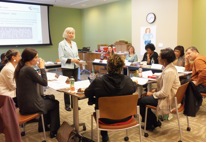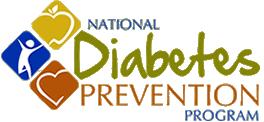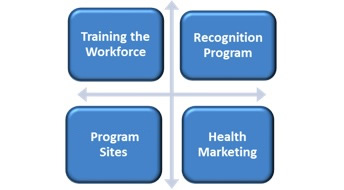
Purpose of the National Diabetes Prevention Program
The remarkable results of the DPP research study and the adapted group-based versions of that study are the foundation for the National Diabetes Prevention Program, which was set up by the Division of Diabetes Translation, CDC, in 2010.
The program’s purpose is to expand on the success of the DPP research study and to systematically scale, support, and sustain lifestyle change programs to prevent type 2 diabetes in communities across the United States.Purpose of the National Diabetes Prevention Program
The following are the key factors that support the National Diabetes Prevention Program:
Hover your mouse over each key factor for more information
This program is evidence-based. It works. And it can be sustained.
Four-Pronged Approach
The National Diabetes Prevention Program has four key components:
Hover your mouse over each component for details
Group-Based Lifestyle Change Program
The backbone of the National Diabetes Prevention Program is the group-based, structured lifestyle change program. This program helps participants make lifestyle changes to reduce their risk for type 2 diabetes. As a Lifestyle Coach, you will work with groups of participants to reduce their risk by 1) losing weight through healthy eating, 2) being more physically active, and 3) learning to recognize and overcome barriers to healthy eating and physical activity.

“We’re not changing people directly; we’re giving them the tools to change their risk.”
Group-Based Lifestyle Change Program cont'd
The National Diabetes Prevention Program lifestyle change program has two parts that make up the year-long program:
- Months 1-6
The Months 1-6 curriculum focuses on how to adopt a lifestyle that includes healthy eating and physical activity. The 16 sessions help participants develop lifelong skills for healthy living through step-by-step changes. Participants stay in the same group throughout the 16 sessions and usually meet weekly at the same location and time.
- Month 7-12
Following the 16 weekly sessions, Lifestyle Coaches offer monthly sessions. The content is more flexible than the content of the Months 1-6 sessions; it can be tailored to topics of relevance to the participants. The monthly sessions provide participants with additional support and learning opportunities, and they help participants transition from having frequent support from a Lifestyle Coach and group to maintaining their lifestyle changes independently.
The National DPP lifestyle change program is a one year program.
Months 1-6 Curriculum
The Months 1-6 sessions are the most structured phase of the program. All participants are given the same information about weight loss and physical activity and are given the opportunity to practice behavioral skills both during the sessions and at home. The Months 1-6 curriculum consists of three sections:
Learning skills: Sessions 1-7
This first section focuses on the basic skills related to healthy eating and physical activity:
- Monitoring food intake
- Eating less fat and fewer calories
- Eating healthfully
- Being physically active
- Balancing eating and physical activity for weight loss
Months 1-6 Curriculum cont'd
Controlling the external environment: Sessions 8-10
This section addresses how participants can best deal with elements in their environment that stand in the way of lifestyle change. Topics covered include:
- Changing one’s surroundings
- Problem solving
- Healthy eating when not at home
Dealing with psychological and emotional issues: Sessions 11-16
The third section targets psychological issues related to weight loss and long-term change. Topics covered include:
- Overcoming challenges
- Managing stress
- Staying motivated
Months 7-12 Sessions
Many people have difficulty maintaining weight loss. This situation is especially true when participants transition to being on their own after having weekly sessions and regular contact with a group of people who are going through the same difficulties as they are. For that reason, the lifestyle change program includes monthly sessions to provide additional support and learning opportunities for participants after the initial 16-session phase.
Months 7-12 participants fall into three categories:
- Participants who were not able to achieve their weight loss and physical activity goals: they use the monthly sessions to continue working toward their goals.
- Participants who did achieve their weight loss and physical activity goals but regained weight or slipped in their adherence to healthy eating and physical activity after the 16 weekly sessions were over: they use the montly sessions to get back on track.
- Participants who did achieve or surpass their goals and were able to sustain these changes: they use the monthly sessions to set new goals or to focus on how to maintain their new habits for a lifetime.
Months 7-12 Sessions cont'd
The Months 7-12 sessions, led by Lifestyle Coaches, are held monthly rather than weekly, and they continue for 6 to 8 months. The longer time between classes allows participants to receive continued support and also allows them to learn to be accountable to themselves alone.
The Months 7-12 sessions revisit key themes of the previous curriculum (e.g., self-monitoring, setting goals, staying motivated, and overcoming barriers). Sessions also reinforce the concept of energy balance – calories in balanced against calories out. Sessions may also go into more detail on subjects discussed during the Months 1-6 phase (e.g., promoting variety and balance in one’s dietary intake, handling social cues during special occasions, and staying motivated).
Role of the Lifestyle Coach
The Lifestyle Coach leads the yearlong curriculum at recognized National Diabetes Prevention Program sites. Central to the success of the lifestyle change program is a good relationship between the Lifestyle Coach and each participant and among the participants as a group.
The Lifestyle Coach is responsible for fulfilling several roles throughout the course of the program:
 Provides information and support
Provides information and support
First and foremost, the Lifestyle Coach supports the participants by providing information, encouraging any progress, and working with the group to overcome any challenges or barriers that arise. Lifestyle Coaches should always look for effort and success by each participant and build on it, no matter how small or gradual.
Role of the Lifestyle Coach cont’d
- Guides participants through the lifestyle change program
Lifestyle Coaches do not need expertise in diabetes, nutrition, or physical activity to deliver the lifestyle change program. Their role is not to give information on diabetes or any other medical condition. All the information they are required to give is in the program materials. What Lifestyle Coaches do need, however, is an ability to guide lifestyle change, help participants develop the skills they need to adopt a healthy lifestyle, and empathize with the challenges participants face as they try to make these lifestyle changes. The best Lifestyle Coaches deliver the program as it is designed and add only their personal strengths and abilities as presenters and group facilitators.
Role of the Lifestyle Coach cont'd
- Leverages group dynamics
Lifestyle Coaches use group dynamics to instill accountability within participants and to seek solutions to barriers and challenges. The Lifestyle Coach facilitates and promotes group discussion whenever possible and appropriate. Good group dynamics is a major element in the success of the lifestyle change program. - Reinforces material participants already learned
The topics covered in the weekly curriculum build on one another. Lifestyle Coaches continually reinforce and integrate the old material into the new material (i.e. refer often to previous lessons and discussions). The practice of regularly revisiting information, strategies, and discussions from previous lessons will help to connect the many topics discussed during the program. At a minimum, reinforcing material should include summarizing the previous week’s lesson at the beginning of each session.
Role of the Lifestyle Coach cont'd
- Maintains high expectations
Lifestyle Coaches maintain the highest standards and expectations. Goals should not be reduced to match what seems doable for a participant, although the way that goals are pursued may be tailored to individual circumstances. Instead, the Lifestyle Coach expresses confidence that all participants will reach and maintain their goals and helps each participant overcome any barriers he or she encounters.
- Establishes accountability
Lifestyle Coaches create an expectation of accountability among the participants and between themselves and the participants. Accountability is created by setting clear and consistent expectations and committing to them.
Role of the Lifestyle Coach cont'd
Below are examples of commitments by Lifestyle Coaches and participants:
Lifestyle Coach’s Commitments:
- To start meetings on time.
- To weigh all participants weekly.
- To stop weigh-ins when it is time to start the meeting. Late comers are weighed after the meeting.
- To assist participants with self-monitoring and problem solving.
Participants’ Commitments:
- To attend all sessions, or let the Lifestyle Coach know in advance that they will be absent.
- To be on time.
- To keep track of food intake and physical activity.
- To discuss problems and challenges with the Lifestyle Coach or the group.
Good group dynamics is a major element in the success of the lifestyle change program.
Key Principles
The National Diabetes Prevention Program lifestyle change program is based on several key principles that guide the content of the program and that determine the roles of the Lifestyle Coach and the participants:
- Goals are clearly defined and realistic.
- Participants self-manage their food intake and physical activity.
- Lifestyle Coaches are supportive, accepting, and empathic.
- Participants’ realities and needs are taken into account.
- Lifestyle Coaches adhere to the National Diabetes Prevention Program’s curriculum.
Next we discuss each principle in detail.

Principle: Goals are Clearly Defined and Realistic
Setting goals is the centerpiece of the lifestyle change program. Working toward goals is the foundation for achieving and maintaining lifestyle changes and, ultimately, preventing type 2 diabetes. From the beginning of the program, Lifestyle Coaches state these goals without equivocation and set high expectations that participants will achieve them before the 16-session weekly program is over and maintain them for life.
All participants in the lifestyle change program are assigned two primary goals:
- Achieve and maintain a weight loss of 7% of their initial body weight.
- Achieve and maintain at least 150 minutes of moderate physical activity per week.
These goals are based on the findings of the DPP research study and are shown to prevent or delay type 2 diabetes in those at high risk.
- 7% body weight loss
- Moderate physical activity of 150 minutes per week
Principle: Goals are Clearly Defined and Realistic cont'd
Weight Loss Goal
 So, why is the goal set at 7% weight loss? Why not 10% or 15%? More is better, right? The original DPP research study focused on 7% weight loss because the researchers believed 7% to be safe, effective, and feasible. Although many participants can lose 10% of their body weight within 16 weeks, the researchers determined that a 7% loss is more attainable and more easily maintained. Losing 7% of body weight averages to a loss of about 1 to 2 pounds per week during the Months 1-6 phase, for a total of 15-30 pounds at the end of 20-24 weeks.
So, why is the goal set at 7% weight loss? Why not 10% or 15%? More is better, right? The original DPP research study focused on 7% weight loss because the researchers believed 7% to be safe, effective, and feasible. Although many participants can lose 10% of their body weight within 16 weeks, the researchers determined that a 7% loss is more attainable and more easily maintained. Losing 7% of body weight averages to a loss of about 1 to 2 pounds per week during the Months 1-6 phase, for a total of 15-30 pounds at the end of 20-24 weeks.
Weight loss through structured lifestyle change is the single most important step people can take to prevent or delay type 2 diabetes. Participants must lose weight in order to reap the health benefits. Realistically, not all participants will achieve the weekly or program-long weight loss goals, but participants will probably realize some health benefits anyway. As shown by the DPP research study, even small amounts of weight loss produced some benefit in preventing or delaying type 2 diabetes.
Principle: Goals are Clearly Defined and Realistic cont'd
Weight Loss Goal cont'd
Remember that the lifestyle change program is not just a weight loss program: it is a program to prevent type 2 diabetes. Achieving the weight loss goal (or even getting part way to the goal) produces a wide range of health benefits other than being able to fit again into a prom dress or pants that have not fit in 10 years.
The Lifestyle Coach monitors participants’ weight loss goal by weighing each of them at each session (beginning at Session 1) and recording their weight in the Lifestyle Coach’s Log. The starting (baseline) weight is used to establish the participant’s weight goal. Note that each participant must be weighed in private.
Some participants may not want to be weighed by the Lifestyle Coach, and some may even refuse. Such a situation is not unexpected. However, to be in the National Diabetes Prevention Program, participants must agree to weigh-ins at each session and must develop the habit of weighing themselves at home. Weigh-ins are essential to the success of the participants’ personal goals. In addition, weigh-ins are tied to funding and recognition for the program.Weight loss through structured lifestyle change is the single most important step people can take to prevent type 2 diabetes.
Principle: Goals are Clearly Defined and Realistic cont'd
Fat Gram Goal
To achieve their weight loss goals, participants are given a fat gram goal (the maximum number of fat grams they may eat per day). The purpose is to limit the amount of fat and calories they consume. Keeping fat grams below 25% of calories consumed is based on findings from the DPP research study. Such a goal is effective, safe, and feasible. There are several reasons for focusing on fat.
- Fat grams are calorie-dense.
Fat is the most calorie-dense type of food. For example, fat has more than twice as many calories per gram as protein or carbohydrate. Of course, not all fat is bad; it just has more calories than other types of food.
- The message is simple.
Focusing on fat simplifies the message and streamlines self-monitoring requirements. Controlling fat grams is an easy and obvious way to control calories, since in most cases, eating less fat also means eating fewer calories. It also gives participants flexibility: they can eat virtually any foods they want as long as they lower their fat intake and thus lose weight.
Principle: Goals are Clearly Defined and Realistic cont'd
Fat Gram Goal cont'd
- Fewer calories from fat contributes to healthy eating.
Lowering fat intake emphasizes overall healthy eating whereas imposing a restrictive diet emphasizes weight loss alone. Reducing fat grams often enables participants to eat larger volumes of other calorie sources, such as whole grains, fruits, and vegetables. By eating less fat, they may actually be able to eat more food, provided that the food they eat is low in fat and calories.
- Less dietary fat improves insulin sensitivity.
Excess fat stored in the body makes the body less sensitive to insulin. With less fat in the body, insulin can work more effectively. - Keep in mind that eating less fat is a new way of eating, not a diet. The word diet often has a negative connotation and may carry baggage for participants. It may be associated with restriction, fad diets, and feeling hungry all the time. Throughout the program, be sure to use terms such as healthy eating instead of diet.
Principle: Goals are Clearly Defined and Realistic cont'd
Monitoring Fat Grams and Calories
Although the primary focus throughout the lifestyle change program is on reducing fat grams, calories are also discussed in detail. Participants are asked to track their calorie intake as part of their daily self-monitoring. A calorie goal is not included in the lifestyle change program, although participants who are behind on their weight loss goal by Session 7 are encouraged to sharpen their focus on calorie reduction. Throughout the lifestyle change program, participants are encouraged to self-monitor the calories they eat and to lower their intake to a level that supports weight loss.
A calorie is a unit of measure that indicates the amount of energy taken into the body through food. It is also a measure of the energy the body uses.
Principle: Goals are Clearly Defined and Realistic cont'd
Physical Activity Goal
 The lifestyle change program sets a physical activity goal of at least 150 minutes per week for each participant. Evidence shows that this goal is feasible, maintainable, and likely to be beneficial in preventing type 2 diabetes. It is also attainable, especially when divided into segments of 30 minutes a day. Even the daily 30 minutes may be divided into as many as three segments. However, each segment of activity must last at least 10 minutes without a break.
The lifestyle change program sets a physical activity goal of at least 150 minutes per week for each participant. Evidence shows that this goal is feasible, maintainable, and likely to be beneficial in preventing type 2 diabetes. It is also attainable, especially when divided into segments of 30 minutes a day. Even the daily 30 minutes may be divided into as many as three segments. However, each segment of activity must last at least 10 minutes without a break.
Principle: Goals are Clearly Defined and Realistic cont'd
Physical Activity Goal cont'd
The benefits of physical activity are numerous for people at risk for type 2 diabetes:
Hover your mouse over each bullet for more info.
Principle: Goals are Clearly Defined and Realistic cont'd
Physical Activity Goal cont'd
The Lifestyle Coach should encourage all types of physical activity. Work with participants, however, to ensure that the level of activity is strenuous enough to produce health benefits. Most participants, especially if they have not been active before starting the program, use brisk walking as their primary choice of physical activity.
The National Diabetes Prevention Program is not just a weight loss program; it is a program to prevent type 2 diabetes.
Principle: Participants Self-Manage Their Food Intake and Physical Activity
Throughout the program, participants make personal choices about how to achieve their goals. They decide what to eat, how to incorporate physical activity into their schedules, and how to deal with forces that challenge their efforts at lifestyle change. The lifestyle change program is the template; each participant adds his or her own action steps. The Lifestyle Coach guides and supports participants throughout this process of self-management.
 The lifestyle change program focuses on giving participants tools that they can apply to their individual needs and situations. These tools include materials to help with self-monitoring, techniques for developing personal goals and action plans, and strategies for problem solving. These tools allow participants flexibility in their choice of food and activity, and they reinforce the expectation that participants can shape and evaluate their own program and their own progress. These tools also help participants develop the skills to succeed on their own, both during and after the lifestyle change program.
The lifestyle change program focuses on giving participants tools that they can apply to their individual needs and situations. These tools include materials to help with self-monitoring, techniques for developing personal goals and action plans, and strategies for problem solving. These tools allow participants flexibility in their choice of food and activity, and they reinforce the expectation that participants can shape and evaluate their own program and their own progress. These tools also help participants develop the skills to succeed on their own, both during and after the lifestyle change program.
The DPP research study found that how well participants self-monitored their food intake and physical activity was the number one predictor of how successful they would be at losing weight.
Principle: Lifestyle Coaches Are Supportive, Accepting, and Empathic.
The Lifestyle Coach and the other group members serve as an essential support network for each participant in the program. Lifestyle Coaches should support — even praise — any effort or progress participants make, no matter how small. Good group dynamics can create a strong atmosphere of support for each member. Indeed, participants are often motivated by fellow group members who are making the same lifestyle changes as they are.
 Lifestyle Coaches must empathize and demonstrate their empathy for the participants when they face challenges during the lifestyle change program. Empathy means identifying with and understanding another person’s situation and feelings. To have empathy does not require that the Lifestyle Coach has direct experience with struggling to lose weight or improve health. Having empathy does require, however, that the Lifestyle Coach must be open to hearing about the experiences of others in a supportive and nonjudgmental way.
Lifestyle Coaches must empathize and demonstrate their empathy for the participants when they face challenges during the lifestyle change program. Empathy means identifying with and understanding another person’s situation and feelings. To have empathy does not require that the Lifestyle Coach has direct experience with struggling to lose weight or improve health. Having empathy does require, however, that the Lifestyle Coach must be open to hearing about the experiences of others in a supportive and nonjudgmental way.
Principle: Lifestyle Coaches Are Supportive, Accepting, and Empathic cont'd.
Furthermore, Lifestyle Coaches need to be aware of the differences between themselves and the clients they serve. Remember that many participants have different eating or physical activity patterns from the Lifestyle Coach. For example, some suggestions or personal anecdotes of a Lifestyle Coach may not resonate with participants. Here is an example of what not to say:
When I feel stressed, I like to go for a three-mile run. It always makes me feel so much better.
Few participants in the lifestyle change program are likely to relate to this type of physical activity. Comments such as this, while seemingly harmless, could cause a divide between the Lifestyle Coach and participants, and potentially undermine the Lifestyle Coach’s credibility. Participants could easily dismiss the Lifestyle Coach, and possibly the entire program, as being out of touch with their realities and needs. The Lifestyle Coach can often keep the discussion relevant and relatable by posing questions to the group, rather than providing examples from his or her own life. A helpful response might be:
What do some of you do to relieve stress?Principle: Participants’ Realities and Needs Are Taken into Account.
Although the structure and overall content of the Months 1-6 curriculum should not change, the Lifestyle Coach needs to tailor some approaches and tools to the needs of various participants. That is, any feedback to, or problem-solving with, an individual participant should take into consideration his or her background, culture, and personal circumstances.
Many factors (e.g., ethnic heritage, culture, socio-economic status, marital status, and work and home responsibilities) may affect the eating and physical activity habits of participants. For example, a single parent of young children may have limited options for regular physical activity. Accordingly, the Lifestyle Coach should work with that individual to find reasonable solutions. The Lifestyle Coach might suggest, for example, increasing physical activity by taking the stairs instead of the elevator, walking during a break or at lunch, or finding a way to include children in a routine.
Another example of a participant who might have difficulty is one who cooks traditional food for his family. Suggesting that he change the type of food he eats may be inappropriate, but suggesting that he prepare foods in a different way (e.g., use less fat, broil instead of fry) or reduce portion size may be effective.
Finally, Lifestyle Coaches must consider the environment in which an individual lives. For example, a Lifestyle Coach would not want to encourage outdoor walking for a participant who does not feel safe in her neighborhood. In such a case, a Lifestyle Coach might suggest walking on an indoor track or in a mall.
Consider participants’ personal circumstances when working with them one-on-one.
Principle: Participants’ Realities and Needs Are Taken into Account cont'd.
The Lifestyle Coach may also have to modify the way in which some participants pursue their goals. For example, if participants have never engaged in physical activity before joining the program, it is unrealistic to expect them to increase their physical activity to 150 minutes per week within 3 to 4 weeks. The end goal, however, should remain unchanged. The end goal is the same for each individual, even though some participants may need to advance at a slower pace than others.
Lifestyle Coaches are not expected to fully understand the background and cultural heritage of each participant. However, they are expected to be sensitive to the differences among participants and to find solutions that work for each of them.
The lifestyle change program is not a one-size-fits-all program. Each participant makes personal choices about how to achieve his or her goals.
Principle: Lifestyle Coaches Adhere to the Curriculum.
The lifestyle change program is based on research that found that people at high risk for type 2 diabetes can prevent or delay the disease through a structured lifestyle program that results in weight loss and regular physical activity. To maintain the effectiveness of the program, Lifestyle Coaches must follow the curriculum of the lifestyle change program as it is designed.
Following the curriculum involves, at a minimum, presenting and discussing all the content included in the curriculum, weighing each participant at every session, and engaging participants to self-monitor their food intake and physical activity. A change to the order or content of sessions or failure to weigh participants at each session decreases the effectiveness of the program and decreases participants’ chances of preventing or delaying type 2 diabetes. Presenting the content and following the structure exactly as described in the Lifestyle Coach Facilitation Guide is essential.

Lifestyle Coaches must follow the lifestyle change program curriculum as it is designed.
Take Home Messages
- The lifestyle change program is a yearlong program, containing two phases: Months 1-6 sessions and Months 7-12 sessions.
- Lifestyle Coaches provide participants with information, support, and guidance. To do so, they use group dynamics, reinforce learning, and confidently expect all participants to succeed.
- All participants are assigned two primary goals: 1) achieve and maintain a weight loss of 7% of initial body weight and 2) achieve and maintain a regular moderate level of physical activity (average of 150 minutes per week).
- Participants must lose weight in order to prevent or delay type 2 diabetes.
- Weight loss goals are closely monitored by weighing the participants at each session.
- How well participants self-monitor their food intake and physical activity is the best predictor of how well they will succeed in reaching their weight loss and physical activity goals.
- Lifestyle Coaches must support and praise any effort or progress by participants, no matter how small.
- To maintain the effectiveness of the program, Lifestyle Coaches must follow the lifestyle change program curriculum exactly as it is designed.
Congratulations!
You have completed the pre-work for DTTAC Lifestyle Coach Training! The training content will build upon what you learned here and provide the information and skills you need to successfully deliver the lifestyle change program.
If you have questions, please contact the Diabetes Training and Technical Assistance Center (DTTAC) at dttac@emory.edu.


